|
This article first appeared as an extension of the Hardy Eucalyptus Page. I think I wrote it in 2004. Many long hours have gone into this completely revised and updated edition, which is starting to turn into a book!
So, it's been several years now since my original online publication of the article documenting the potential of hardy Grevilleas for the Pacific Northwest. In the meantime, we've had floods and record shattering heat waves, faced the wrath of the most "real" winter most of us can remember, the days have lengthened and the grass has grown, and I've adapted a writing style that considers it acceptable to begin articles with the word "so" without any prior context. And what has time taught me about hardy Grevilleas?
I have learned much. In some cases, I was too optimistic. In a few cases, I wasn't optimistic enough. And sometimes I wasn't able to test plants because of the lack of suitable sites remaining for them in the garden. Updated and hopefully more accurate and useful information will follow. First, though, I'll provide an introduction to Grevilleas for those of you who forgot to memorize the original article (since I'm removing it permanently from cyber-land).
AN INTRODUCTION TO GREVILLEA
Grevillea is a genus of plants primarily native to Australia, with a few outliers in New Caledonia, Papua New Guniea, and Indonesia. It is placed within the Proteaceae family, and with more than 200 species it is the largest genus in the family. Although most Grevillea species (with a few exceptions) are restricted in their distribution to a very localized area within Australia, they are adaptable enough that many species are now cultivated throughout Australia, New Zealand, and abroad.
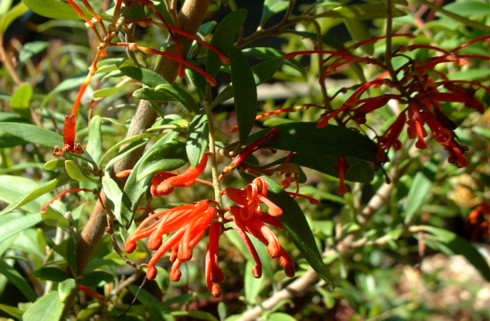
Flowers of Grevillea parvula in my garden, Olympia, Washington
before it froze.
|
Grevilleas deserve much more attention from gardeners in the Pacific Northwest than they have been given. One reason they have been ignored is that most Northwest gardeners are not aware that many species and varieties are much cold-hardier than commonly believed. Literature describes them as being suitable for California gardens, without mention that - as with Eucalyptus, Callistemon, Leptospermum, and others - a significant number of hardier species are native to the frosty mountains of Southeast Australia, and many of these may be grown in the Northwest. These species have spawned numerous hybrids that can also be grown here. While one could argue against the suitability for gardens of plants that are "almost hardy" or "likely to be hardy" to our climate, many species and cultivars of Hebe, Cistus, Phormium, Ceanothus, Escallonia, and other marginally hardy genera continue to be planted all over the Northwest without a second thought. Many of these froze in December 2008, but they still haven't disappeared from nurseries in 2009 - on the contrary, many gardeners are replacing their frozen specimens of these genera with the same plant! Perhaps it is only a matter of time before the popularity of Grevillea in the Pacific Northwest reaches this level. Another reason Grevilleas remain rare is that many people simply haven't heard of them at all.
The virtues of Grevilleas are numerous, especially for urban gardeners, and those who prefer a low maintenance garden. Most of them are very fast growing, tough and competitive. They thrive happily in poor soil, tolerating drought and reflected heat common to urban situations. Many of them also perform well in exposed coastal situations. They are evergreen, with attractive foliage that always looks great. Some species have spectacularly showy flowers that are rich in nectar, attracting hummingbirds far more effectively than most plants that are commonly used to attract hummingbirds. Many of them bloom over a long period, in some cases even through the winter. So there is every reason to get excited about this fabulous group of plants.
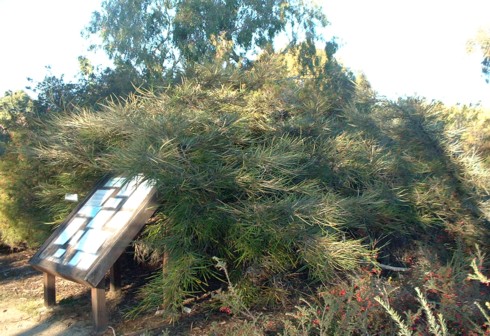
Grevillea aspleniifolia at the UCSC Aboretum.
|
Grevilleas are very easy to grow in gardens, provided a few simple rules are followed. In the Pacific Northwest, they are best suited to full sun. Though some will grow in partial shade, they will not bloom as well without the sun. More recently, I have observed that shade really detracts from the winter-hardiness and overall performance of many Grevilleas. I would recommend only the toughest and most tried-and-true species and cultivars for partial shade: these can make a good understorey for trees such as Eucalyptus that do not cast a lot of shade.
As with all members of the Proteaceae family, Grevilleas should not be fed with fertilizer containing phosphorus. Generally, they require no soil amendment or fertilizer at all once planted out, as their specialized root systems are able to draw out nutrients from very poor soils. They are not suitable for waterlogged soils. In the Northwest, no irrigation is necessary after the first year; but on very dry sites, some summer water will make the plant grow more quickly. Grevilleas exhibit far greater cold hardiness if they are not pampered, and kept on the dry side as much as possible, especially in late summer so that they can harden off. Probably the impression that certain Grevilleas are cold tender is based in part on their performance on sites that are too well irrigated for their best winter performance. All Grevilleas increase significantly in cold-hardiness after having a few years to get established and grow to a large size.
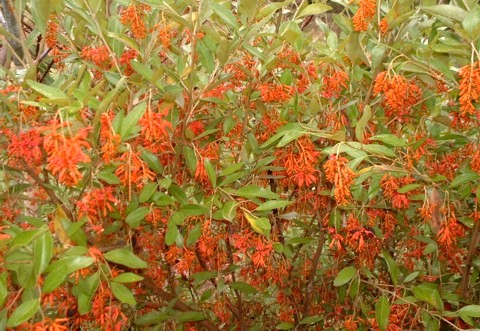
Showy flowers of Grevillea victoriae 'Murray Valley Queen' in my garden.
I took this picture on January 31st.
|
The hardy Grevilleas fall into two main groups: those with spirally arranged inflorescences (which often look like something like brightly colored spiders) and those with inflorescences arranged in one plane (something like a toothbrush). The "spider-flowered" ones always have simple leaves, while the fabulously ornamental "toothbrush-flowered" ones often have compound leaves in various forms. (For the serious enthusiast, this categorization breaks down at a certain point, especially for many of the tropical and tender species which will not be considered here.) After having tried quite a few of each type in various parts of my garden I've come to the conclusion that, in general, the spider-flowered ones are much easier to grow. Most importantly they are able to tolerate a wider range of soils including heavy clay (to a point) and rich loamy soils. Those with larger leaves can even handle some shade, though blooming will be reduced. By contrast, the toothbrush-flowered species really need to be on sharply draining sandy or gritty soils to succeed in frosty, wet-winter climates such as ours. Heavy soils and shade will reduce the frost-hardiness and overall chances of success with these plants. Many of them are so spectacular that gardeners might find it worthwhile to construct a raised bed just for these plants.
Most Grevillea species exhibit considerable variation in the wild, in flower color, leaf size and shape, growth habit, hardiness, and ease of cultivation. For this reason Grevillea species are often referred to by their specific form, which may refer to their features (e.g. 'small-flowered form') or the place in which they were collected (e.g. 'Mt. Slide form'). Because each variant is a different plant with its own uses and cultural needs, it's important for gardeners to retain these names if possible.

Grevillea 'Austraflora Canterbury Gold' in my garden.
|
Names of certain Grevillea cultivars have been muddled quite a bit by nurseries over the years. I have some new information regarding accurate names from Australian Grevillea authority Peter Olde, which is included below in the descriptions of those cultivars affected.
Propagation for most of the hardier Grevilleas is accomplished by tip cuttings taken in the autumn. These are treated with rooting hormone, set on bottom heat, and kept moist through the winter. Rooting is as easy as with many other woody shrubs, but the cuttings must be potted up within a few months of having formed roots, or they are likely to fail. A fine textured soil media containing very low amounts of fertilizer should be used when potting up. Propagating them from seed is not a common practice, except for the tender G. robusta. The practice of grafting Grevilleas has been common in Australia for years, but I've never heard of this being done in North America (someone probably has, but the practice isn't widespread).
Grevilleas remain difficult to find in our region. One may occasionally find a few varieties for sale in the Northwest. California wholesalers marketing plants to Northwest nurseries often carry G. 'Noellii', G. lanigera, varieties of G. juniperina, and others. Local specialty nurseries may offer G. 'Audrey' (under the name 'Poorinda Constance') and forms of G. victoriae. Ask your local nursery to pursue the following Grevillea species and hybrids.
"TRIED AND TRUE" HARDY GREVILLEAS
Here's a list of Grevilleas I can recommend as hardy in most urban or sheltered gardens in the Northwest. If any readers have lost one of these selections to winter cold, I'd suggest trying again with more sun and less water. The following species all belong in the spider-flowered group. Certainly it is a non-exhaustive list to which more species and cultivars may be added in the future.

Grevillea victoriae, the most common cultivated form in North America,
in my garden, Olympia, Washington.
|
Grevillea victoriae. We have a winner! While I've heard of it being killed in the 0 - 10°F range historically, and a few gardeners may have lost it in December 2008 if it wasn't growing under ideal conditions; in general, this species can be considered hardy for most of our urban areas. It is occasionally seen in gardens around the Northwest because it has been propagated for so long by Colvos Creek Nursery and later Heronswood and other nurseries; and because it is a reliable, "tough-as-nails" plant. The usual form of this plant produces fabulous felty bronze flower buds in the fall which open through the winter, and it may produce more flowers sporadically throughout the year. With its 4" long silver-backed, grey-green leaves it always looks splendid. The only problem I have observed is that the blooms may have trouble opening in winter and be prone to abort. In some cases, heavy watering seems to alleviate this problem but in winter it seems to happen regardless, during periods of dark, drippy weather. A number of rare forms of G. victoriae are making their way into cultivation; the following two are the best known so far. 'Murray Valley Queen' is similar to the above, but with superior, larger flowers on a plant of slightly more open habit, and glossier, greener, rounder leaves. 'Marshall's Seedling', also known as 'Marshall Ulbrecht', is possibly a hybrid with another species originating from Western Hills Nursery in California, with smaller leaves and a more angular, spreading growth habit rather similar to that of Grevillea 'Audrey'.

Grevillea juniperina var. sulphurea in the Gerdemann Garden, Yachats, Oregon.
|
Grevillea juniperina has been renowned for its cold hardiness for many years in Britain, where it has endured 0°F. If you can get over the fact that most forms of this plant look like a small green conifer with very prickly needles that try to bite you when you walk past it, you will be rewarded with very attractive flowers. Available forms include the summer-flowering var. sulphurea and the stouter-leafed 'Molonglo', which are yellow; and another form which was designated simply "low red" for a long time until someone came up with the catchier marketing name 'Lava Cascade' - it has orange-red flowers on a plant with an appealing semi-prostrate growth habit. Plant one and tell your neighbors it is a juniper; then watch them stare in awe as brilliantly colored flowers appear at the most unexpected times. They will ask you what they can fertilize their juniper with to get it to do that.

Grevillea 'Audrey', originally sold as 'Poorinda Constance', blooming away in
my garden.
|
Grevillea 'Audrey' (juniperina x victoriae). So you've never heard of Grevillea 'Audrey'? Well you're not alone. With assistance from Grevillea authority Peter Olde, I believe I've figured out that all plants circulating in North American commerce as Grevillea 'Poorinda Constance' are, in fact, 'Audrey'. This error goes all the way back to Australia in the 1970's or perhaps earlier. The real 'Poorinda Constance' is rare in Australia and may not even be in North America at all. It has pure red flowers, which 'Audrey' never does, as described below. So there you have it. Perhaps we should call it "The Grevillea formerly known as 'Poorinda Constance'." In any case, 'Audrey' has been one of the most all-around reliable garden hybrids outside of Australia. Making a silvery-leaved shrub with a rather angular growth habit, it is exceptionally vigorous and tough, with deep orange-red flowers occasionally assuming pinkish tones. In my garden it has outgrown its expected dimensions, reaching 10' tall and 15' across in just 7 years from a tiny plant, with no water, fertilizer or mulch whatsoever; and it blooms for about 11 months out of the year. Light pruning once a year in summer well improve its shape. Along with G. victoriae it seems to attract Anna's hummingbird to my garden all winter. It is hardy to about 5°F. In Australia, it seems to have fallen out of favor as a "junk plant" compared to other Grevilleas. Go figure.
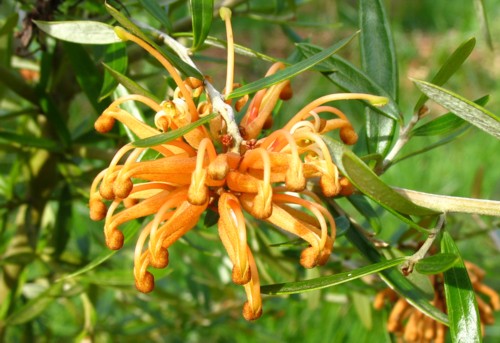
Grevillea 'Poorinda Leane' in my garden, Olympia, Washington.
|
Similarly, Grevillea 'Poorinda Leane' (juniperina x victoriae) now seems to be the correct name for the plant we have all been calling 'Poorinda Queen' for years. This confusion also began in Australia and was imported to the USA along with the plant. 'Poorinda Leane' is overall very similar to 'Audrey' but with tawny yellow to yellow-orange flowers. It is very vigorous and hardy and performs just as well here; in fact, it endured our big freeze of December 2008 in a Whidbey Island garden that dropped to 10°F. As for the real 'Poorinda Queen', it is extremely similar but with more apricot/salmon colored flowers and I can't say I've ever seen one in person.
Grevillea 'Pink Pearl' (juniperina x rosmarinifolia?) is another wonderful plant that is unfortunately surrounded by confusion in the nursery trade. For one thing it is usually written incorrectly as a selection of G. juniperina, which can't be possible, since a true G. juniperina is never pink. Perhaps more significantly, it has been confused with 'Canberra Gem' to such a great extent that many references now consider these to be the same plant. There are, however, two different plants. The mystery of their origins has yet to be resolved, but once again the confusion seems to have originated in Australia and been imported to the US along with the plants. In any case 'Pink Pearl' is an attractive, sturdy, and easily accommodated shrub that grows to about 6' tall and wider, with masses of pink flowers in late winter and spring. Branches develop in what I would call a "plumose" habit of growth, and the deep green leaves are small and prickly on white stems. It is best grown in a mostly sunny to full sun position, and it can tolerate temperatures down to about 5°F.
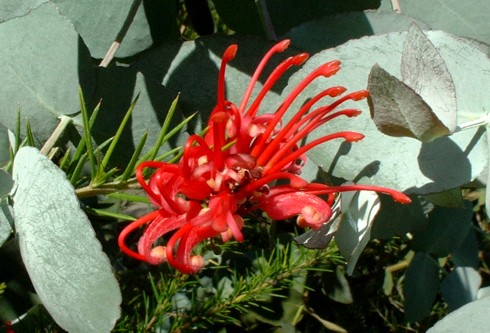
Grevillea 'Canberra Gem' with Eucalyptus cordata in my garden.
|
Grevillea 'Canberra Gem' (juniperina x rosmarinifolia?), compared to 'Pink Pearl', may be described indistinctly as more "untidy looking" in habit (but not irregular), with redder flowers (though still not a true red) and greener stems (but still being a bit white at times). (Is that helpful or what? Ha ha.) The leaves may be slightly longer on average, but they are just as prickly. It seems to bloom later than 'Pink Pearl', typically in mid-spring; and it may grow slightly larger; I'm not sure yet. Other than that it has the same basic characteristics, uses, and hardiness as 'Pink Pearl'. For me it seems to have a more naturally dense growth habit than 'Pink Pearl' and suggests something close to a wild form of G. juniperina.
Next there is Grevillea miqueliana, a close relative of G. victoriae which seems to be just about as hardy as that species. I have two forms of this species, one with large leaves and yellow flowers, and another with smaller leaves and salmon/pink flowers. Both lived through the big freeze of December 2008 in several different situations, with no significant damage. Compared to G. victoriae, the leaves are rounder and greener. The flowers are similar in shape to G. victoriae, but in North American cultivation I'm unaware of an orange or red form of G. miqueliana to match our G. victoriae forms (for that matter, I haven't seen a yellow or salmon flowered G. victoriae in North America either - though all of these combinations are apparently present in the wild). So in that sense these two species, in the forms we do have available, complement each other well. G. miqueliana is very rare now, but is sure to become more popular as its great hardiness, certainly to at least 5 - 10°F, becomes better known.
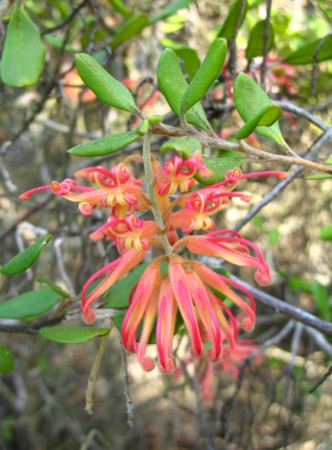
Grevillea miqueliana at the UCSC Arboretum,
Santa Cruz, California.
|
For something different we have Grevillea australis, which is widespread throughout the higher mountains of southeast Australia. It has numerous forms including prostrate forms, narrow leaf forms and wide leaf forms. So far I've only seen an upright, wide-leaf form in cultivation in North America. Not the showiest species, flowers tend to be cream or white and small. However, some forms flower so prolifically as to cover the whole plant - and it is usually fragrant! Also, it is super cold hardy (0 - 10°F). It is the only Grevillea native to Tasmania.
Grevillea 'Austraflora Canterbury Gold' (juniperina x victoriae) is a vigorous and indestructible plant, growing much like a groundcover with the occasional upright branch for a slight mounding effect. The attractive leaves are very soft and felty, and showy sulfur yellow flowers appear over a long period including the winter. This has done well on my garden for many years on heavy clay soil, and is certainly hardy to around the 5 - 10°F range.
VERY PROMISING GREVILLEAS
The following species may (or may not?) turn out to be every bit as hardy as the above, but more testing is needed before I can really be confident about that. A few of the toothbrushies could be placed within this list (notably G. x gaudichaudii and G. rivularis) but I'll discuss them under their own section later.
Grevillea baueri is an attractive plant with almost stem-clasping small green leaves. It grows as a low shrub with numerous ascending small branches with flowers at the tips. With dark pink-red flowers the effect is quite showy. I have only subjected this to cold in a rather limited way so far, and it hasn't tolerated freezing weather in pots as well as I might have expected - but references indicate it may be hardy to at least 10 - 15°F and it seems worth trying in our region. We'll just have to see.
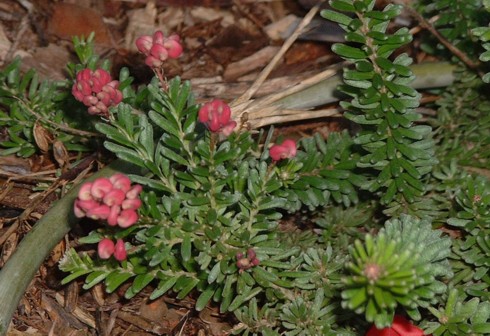
Grevillea lanigera 'Mt. Tamborintha' in my garden.
|
Grevillea johnsonii doesn't fit neatly into either the spidery or toothbrushy group (it appears to be allied to several tropical species), but I'll mention it here. It has pinnate leaves with very deep lobes and long, narrow pinnae. The red-pink flowers are showy up close but so small against the leaves that the wispy foliage is really the main feature of this plant when viewed from a distance. It comes from high altitudes and cold basins in eastern Australian mountains, and should be able to handle at least 12°F. It is reported to be difficult to root from cuttings; I've also tried it from seed a couple times but never gotten it to germinate.
Grevillea lanigera comes from both mountainous and coastal areas of southeast Australia, yet it is still only grown much in California where it bakes in the heat. It is a more diminutive small scale plant than most Grevilleas, and worth looking into if you don't feel like you have room to accommodate a vigorous large plant. It has narrow, soft leaves and makes nice pink flowers in the summer (or other colors on some forms). The form 'Mt. Tamborintha' often seen for sale is an attractive small groundcover. It would certainly be a good rock garden plant; I had no trouble growing it in my garden for a long time where it thrived on wet clay soil. As for hardiness, I'm not sure whether it was cold or a lack of sunlight that killed my plant. I'd call 'Mt. Tamborintha' hardy to at least the 15 - 17°F range, and worth more testing, as it may be able to handle lower temperatures. As usual the other forms are all worth testing as well.

Grevillea lavandulacea 'Penola' at Jungle Fever Exotics, Tacoma, Washington.
|
Grevillea lavandulacea is a widespread species in southern Australia with many variations and forms. Generally the plants are small (to 2 - 4') with small, narrow leaves and brightly colored flowers. Although not native to especially cold locales, some forms and cultivars of this plant seem to be surprisingly hardy. The form 'Penola' has really impressed me; it once handled 12°F with no real damage, but later the same plant died during a freeze of much longer duration during which the lowest temperature was 16°F. Not a big plant, it needs full all day sun and freedom from competition with other plants to thrive. But, it is cold hardy, and what a show of bright red flowers it makes in summer! Further trialing is needed for 'Penola' and other forms of this species, but the need for a hot sunny spot can't be emphasized enough.
Grevillea 'Orange Sparkler' (rosmarinifolia x 'Canberra Gem'??) is a cultivar originating as a chance seedling at Joy Creek Nursery in Scappoose, Oregon. It looks quite a bit like 'Audrey' but with oranger, rounder, more hanging flowers. A detailed analysis may determine whether it is in fact a hybrid, or just a form of G. rosmarinifolia. New to cultivation, but it sounds like a winner!
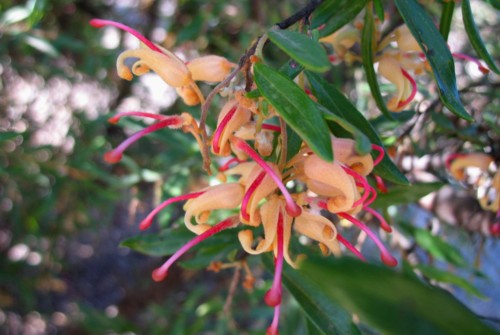
Grevillea 'Poorinda Elegance' at the UCSC Arboretum, Santa Cruz, California.
|
Grevillea 'Poorinda Elegance' (juniperina x [alpina x obtusiflora]?) is similar in habit to 'Audrey' but has beautiful bicolored flowers in red and yellow. Although stunning to look at up close, they are often hidden amongst the leaves rather than being held at the ends of the branches. For this reason it has never been very popular, but I think it is still a very nice plant and just has to be placed where it can be appreciated at a close range. I can't quite place it in the super-hardy clan as yet, but the 15°F range seems to be safe for now and it will certainly thrive in sheltered Northwest gardens while we await further testing.
Grevillea 'Scarlet Sprite' (rosmarinifolia x something else?) is a beautiful plant with a delicate soft texture unrivalled by about anything. The tiny, soft, needle-like leaves are bright green on whitish stems. Prolific dark pink flowers seem most likely to occur in late spring or summer. It survived 12°F in a pot for me on one occasion, but I've also killed it a couple times, so I'm hesitating to put it on the proven-hardy list until I get more consistent results. Although commonly asserted to be a form of G. rosmarinifolia, authorities now regard this to be a true hybrid and thus more correctly stated without including the 'rosmarinifolia' part in its name.
HONORABLE MENTION: HARDY-ISH GREVILLEAS
The following species don't quite make the cut in the Pacific Northwest according to most gardeners' standards for winter hardiness. However, they're still interesting and fun to try, and may persist for many years in a sheltered garden. Some may also be suitable for containers.
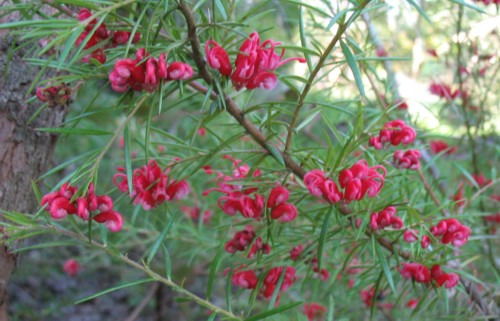
Grevillea 'Clearview David' in my garden.
|
Grevillea alpina makes a mounding shrub to 2 - 4' tall and wide. The small green leaves are variable in shape and may be linear or rounded; and the flowers, though smaller than some species, are in scale with the plant and reasonably showy. Despite the epithet 'alpina' this species (mostly from Victoria) doesn't grow in the coldest mountain areas. It is native to moderate elevations and varies quite a bit in hardiness. In my experience so far, most of them seem to have their limit in the 15 - 20°F range. 'Mt. Dandenong' may be one of the better forms with superior hardiness and good pink/yellow flower coloration as well. 'East Grampians' with red and yellow flowers persisted for many years in my garden until December 2008; I'd rate it to about 18°F. A 'yellow' form I planted turned out to be rather tender. All are slow growing here and will be best in a hot sunny spot free of competition from other plants, if attempted.
Grevillea 'Clearview David' (rosmarinifolia x 'Crosbie Morrison') must be one of the very easiest Grevilleas to propagate and grow. Vigorous but not overwhelmingly fast growing, its needle-like green leaves recall those of 'Canberra Gem' but they are softer. The very bright, deep red flowers are more compact than those of 'Canberra Gem' and the plant itself is more compact, reaching about 4' x 6' in size. This plant is super easy to please; it did well in my garden for a long time, but turned out not to be hardy below about 18°F.
Grevillea oleoides is a variable species with narrow, linear, silky leaves. It usually has a dense, appealing habit with upswept branches. The red flowers hang down on the undersides of the branches. It is not a huge plant; it may reach 4' or more and wider. It's a nice plant but it seems to have problems below about 18°F in our climate.
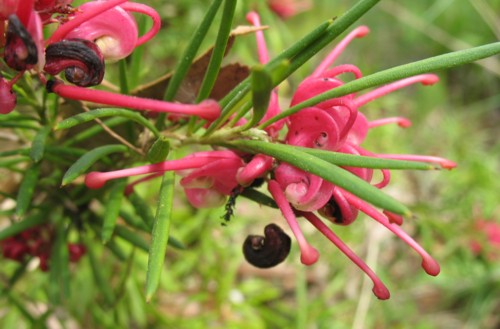
Grevillea rosmarinifolia in my garden.
|
Grevillea rosmarinifolia is an extremely variable plant represented by a large number of very different forms, some of which may be reclassified as their own species. Many of the best ornamental forms are unavailable in North America, but many of these seem unlikely to be as cold-hardy as those we do have. Flower color ranges through various shades of pink, often with some white flower parts. Light pink and white can usually be expected from plants in cultivation. It is a sturdy, easily grown, and vigorous plant that requires little care and always looks nice. I've seen the following forms in North American cultivation: one has grey leaves and pink flowers, and actually makes an excellent combination of cold hardiness and ornamental appeal. I'd say this form is safe to at least 15°F, and further testing may prove it to be hardier. The widely available, pine-green leaved, red-flowered 'Noellii', popularly regarded as a hybrid cultivar but apparently just a selection of G. rosmarinifolia (and not one of the most exciting Grevilleas anyhow from an ornamental standpoint, in my view), is hardy to around 15°F as well. I have seen it thriving in many Northwest gardens despite being slightly less hardy than those on my "proven hardy" list. A very vigorous form of G. rosmarinifolia I once tried, with large, lighter green leaves and big pink flowers, seems to die out in the 22 - 24°F range. Once again further testing may demonstrate certain other forms to be quite hardy.
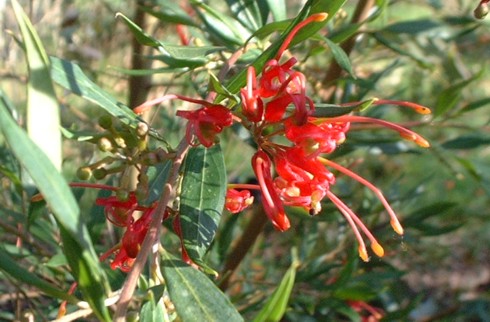
Grevillea 'Ruby Clusters' flowering in January in my garden.
|
Grevillea 'Ruby Clusters' (oleoides x shiresii) is a large shrub to 10' tall and 15' or more across with deep green leaves, and flowers that are a very bright, deep ruby red almost leaning towards magenta. The flowers are too dark to be spectacular from a distance so it is important to site this plant where it can be appreciated up close. This is a beautiful plant that always attracts attention as a potted specimen for sale, and it performs beautifully in the Pacific Northwest until it gets too cold. If it's established and well hardened off, it can survive down to about 15 - 18°F. If it's not hardened off it dies in the 20's F.
DISAPPOINTMENTS
Here are a few Grevilleas that I expected to be hardier in the past, but that have since demonstrated themselves not to be very cold hardy or suitable for Northwest cultivation.
First of all I'll get Grevillea robusta out of the way. I'm reminded of the Gin Blossoms' song "Jealousy" which contains the line "If you don't expect too much from me, you might not be let down!" After trying it four times, no, it's still not at all hardy for me, nor is it hardy anywhere in the Pacific Northwest when a "real winter" comes along. But I can't call it a true disappointment, since I wasn't expecting it to be successful.
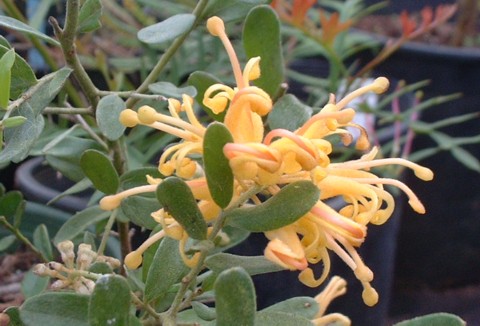
Attractive leaves and flowers of Grevillea 'Poorinda Golden Lyre'
at The Desert Northwest.
|
Grevillea 'Poorinda Golden Lyre' (alpina x victoriae) looks a lot like 'Austraflora Canterbury Gold' but with really cool, blunt-ended leaves and more decorated, almost bell-like yellow flowers. Most references state it is very hardy, but as yet, I've not gotten it to live below 22°F. It's now lost from my collection, and while I might not otherwise miss it, it's apparently now almost extinct in general cultivation, which seems a shame since it's (to me) a distinctive and very appealing ornamental.
Grevillea parvula is a recent name for the plant long known as G. victoriae var. leptoneura. I originally purchased it under the latter name thinking, great, it's a different form of G. victoriae and people will go gaga for something that is just as hardy but with a different look. The foliage is smaller and yellower than regular G. victoriae, with deep red flowers on the form I had. Soon after hyping it up, I discovered that this plant can't handle temperatures below about 22°F in our climate. Perhaps with the new name disassociating it from G. victoriae, we can now more easily accept that it's just not hardy.
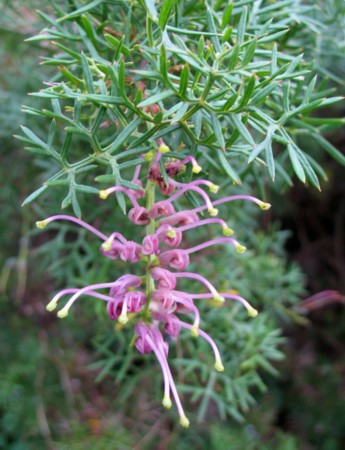
Grevillea rivularis at San Francisco Botanic Garden,
California.
|
TOOTHBRUSHY TEMPTATIONS
If none of the preceding plants grabs you, or if you've just never been tempted by a toothbrush, here is a group of doubly intriguing Grevillea species and hybrids. The toothbrush-flowered Grevilleas, with their showy, flattened flowers and frequently broad, lobed leaves, take the gardener one step closer to the holy grail of exotic gardening, wherever that may be.
Although some of these come from cold, snowy, and mountainous areas in the wild, it's a formidable challenge to pick out any that are truly hardy in the Pacific Northwest. They simply don't perform as well in our winters as would be expected based on the spider-flowered Grevilleas from similar areas. So, you ask, why aren't these hardier for us? What's the deal, man? I'm not completely certain, but here's one possible idea, which I shall attempt to summarize as briefly as I can. The peculiarities of regional climates dictate that when it gets really darn cold in the mountains in Australia, the humidity of the atmosphere is always at or near 100%. When it gets really darn cold in the Northwest, humidity usually drops off to 10 - 40% for at least part of that period. Many Australian plants (most notably Acacias, but others as well) seem far better able to cope with cold when humidity is high, and are not adapted to handle the combination of severe cold and low humidity. This is because the added stress factor of desiccation contributes to plant tissue damage beyond the damage inflicted by the temperature itself. Since plants transpire water from their leaves, it follows that plants with larger leaves (among other factors) are more sensitive to moisture loss during times of stress. And the toothbrush-flowered Grevilleas, on average, have larger leaves with much more exposed surfaces than the spider-flowered ones. Admittedly I have no scientific verification specifically pertaining to Grevillea for this hypothesis, but it seems like a plausible idea.
Now that I've said all that, at least two toothbrush-flowered Grevilleas still stand out as being very promising for Northwest gardens in my assessment.
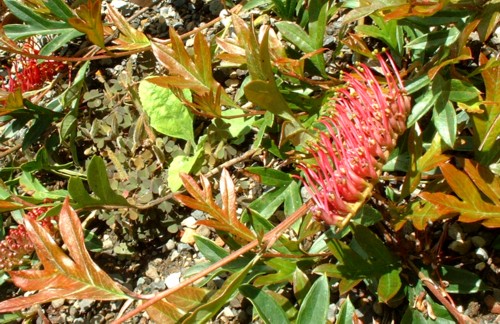
Grevillea x gaudichaudii at Cistus Design Nursery, Suavie Island, Oregon.
|
Grevillea x gaudichaudii (acanthifolia x laurifolia) is a natural hybrid between two species from the Blue Mountains in Australia. Although its form in the wild varies from shrubby and upright to creeping, I have only seen one form in North American cultivation: a prostrate or slightly mounding plant, which essentially functions as a groundcover. It has outstanding lobed green leaves (the new growth being bronzy to reddish) with deep red to almost purple large toothbrush flowers. Another excellent plant for covering banks or hillsides, or a large drier area of the garden, it seems to require very good drainage to perform well. Other forms of this hybrid should be introduced to cultivation as well. It seems to be able to handle temperatures in the 10 - 14°F range if it's properly sited and well hardened off - and perhaps it can go lower.
The other really hardy toothbrushy one is Grevillea rivularis, a fun plant with billows of deep green, prickly, deeply lobed foliage. Pendant inflorescences at the branch tips are showy enough but don't scream at you: pastel shades of pink and lavender are the norm. It may eventually reach dimensions of about 6' x 10' or more. It actually seems to prefer some summer water in our climate, and might even benefit from a little shade in the hottest Northwest gardens. I did lose this plant once over the winter on heavy clay soil when the temperature dropped to 20°F, but on another occasion it survived the same temperature undamaged in a pot. I would suggest 10 - 15°F as a probable hardiness range for this species if it's properly sited, established, and hardened off.
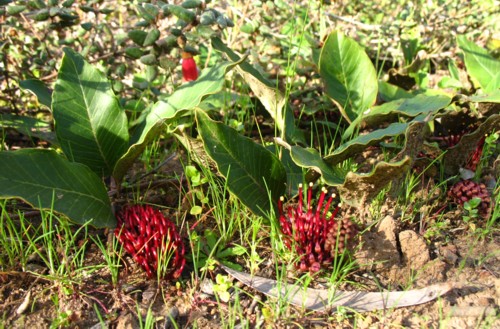
Grevillea laurifolia at the UCSC Arboretum, Santa Cruz, California.
|
Those two are my top recommendations, but certainly many more are worth looking into. For starters, Grevillea acanthifolia, one of the parents of G. x gaudichaudii, is a mid-sized shrub with divided, slightly spiny green leaves and showy pink or mauve toothbrush flowers at the ends of the branches, which are usually produced in the summer here. Although it is one of very few hardy Grevilleas that is reported to tolerate poorly drained soils in Ausutralia, my first plant did not tolerate clay soil and died in its second winter. Its hardiness on an ideal site may be in the 12 - 15°F range, but time will tell.
The other parent of G. x gaudichaudii, Grevillea laurifolia, is also interesting. A prostrate groundcover, it comes from the Blue Mountains and surrounding areas of New South Wales. It has bronzy-felty new growth and deep red flowers held like toothbrushes above the foliage, spreading out in a prostrate mat in all directions. Although slow to establish, it is a sturdy plant that appreciates cooler growing conditions (although it needs sun, a baking hot spot might roast it) and well-drained soil. At least two forms of it are in North American cultivation, and as with G. acanthifolia, a preliminary educated guess as to its hardiness might be 12 - 15°F.
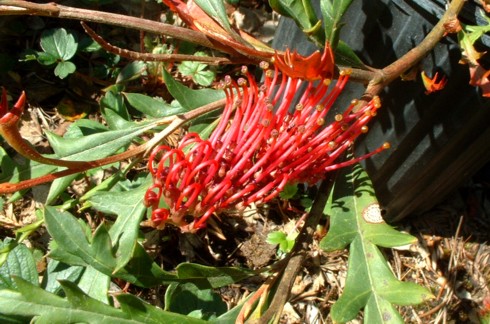
Grevillea 'Austraflora Fanfare' at The Desert Northwest.
|
Grevillea 'Austraflora Fanfare' (x gaudichaudii x longifolia) is an outstanding hybrid that is sometimes available from California nurseries. It is a very vigorous groundcover with beautiful serrated leaves, and screaming red toothbrush flowers over a long period. It may spread as much as 15' across while remaining under 1' tall. Like G. 'Poorinda Royal Mantle' it has great potential for use covering banks and hillsides. It is more vigorous than G. x gaudichaudii, but unfortunately it's not quite as cold hardy, probably thanks to the parentage of less-hardy G. longifolia. I'm not exactly sure yet but somewhere in the 14 - 20°F range seems to be about its limit. A newer hybrid, 'Aussie Crawl', looks quite similar and should also be tested for hardiness; though I've yet to see this in North American cultivation.
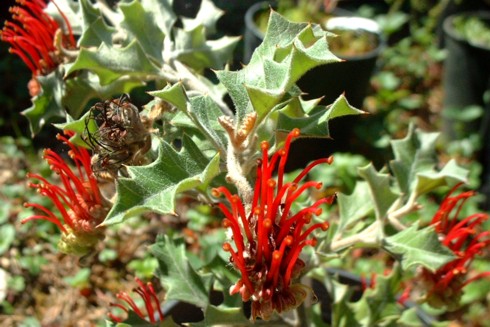
The red flowered form of Grevillea aquifolium at The Desert Northwest.
|
Grevillea aquifolium comes in several forms, all with holly-like leaves. Some forms have felty grey new growth, which is very attractive. Flowers may be yellow or red, and spring seems to be the most common flowering time in our climate. This species has proven to be hardier than I expected, even tolerating heavy clay soil (though it was never really happy about it). A rather slow grower here, it appreciates a hot sunny spot and no competition from other plants. Even forms originating in places that aren't very cold show impressive hardiness, usually to about 15 - 20°F if they're well hardened off - but again, more testing may prove certain forms to be hardier.
Grevillea barklyana is a rare species that may not be in North American cultivation at all. But I have to mention it because it's a tree (to 20' or so), and, supposedly, it's hardy. It has very large leaves and doesn't look like it ought to be hardy, so I have my doubts, but one still has to try as it comes from a cool montane rainforest in Victoria, Australia. The UCSC Arboretum has a plant labeled G. barklyana, from which they have sold many rooted plants, but these are actually G. macleayana. I tried G. macleayana and found it to be hardy only to about 25°F. The real G. barklyana is very fast growing and upright, having huge leaves (to 1' long) with occasional lobes, and pink toothbrush flowers. A few wild plants have been found to have superior flower colors of deep pink or red; these should be propagated vegetatively and introduced. When will we get a chance to try this species and find out if it's really hardy? Stay tuned.
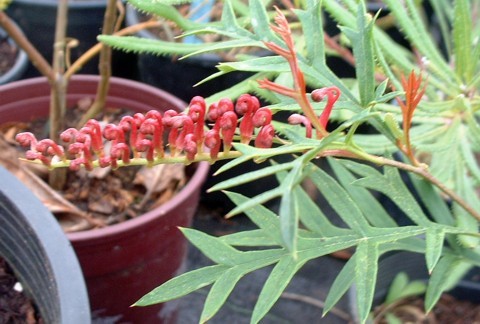
Grevillea 'Bronze Rambler' at The Desert Northwest.
|
Grevillea 'Bronze Rambler' (rivularis x 'Poorinda Peter') is a large, low shrub (or essentially a tall groundcover) having tough bronzy leaves with very large lobes, and crimson-magenta toothbrush flowers. Another outstanding texture plant for the garden, it is supposed to be hardy to all kinds of difficult conditions and poor soil. It didn't quite manage to survive a dip to 13°F its first winter in the ground, but it seems like it almost did and I was reasonably impressed. (Sadly this plant is now lost from my personal collection, but hopefully I'll remedy that at some point.) I would expect it to be able to handle 15°F or perhaps a little lower once established.
Grevillea willisii is another rather exciting species, because it is such a large grower, and all evidence points to it being quite hardy. It is typically a large, almost tree-like shrub to about 10' tall and a little wider. The deeply lobed leaves are dark green and showy cream toothbrush flowers are produced at the ends. Additionally, there is (or at least was) a "long leaf form" of this species that grew into a larger tree, with much larger leaves and flowers. However, it has not been located in the wild in many years, and apparently it has not been preserved in cultivation, so it may be extinct. But there is always hope that it is still out there. G. willisii comes from rather cold areas near Omeo, Victoria and seems like it ought to be hardy to 10°F or lower - but we just don't know yet. Apparently it was in cultivation at the UCSC Arboretum at one point, but I've never actually managed to find it there and I suppose it's probably gone. Surely someone, somewhere in California, must still have one.

Grevillea 'Poorinda Royal Mantle' in my garden before it froze, August 2006.
|
And finally, here are a few not to bother with, which I'll mention just because I used to be hopeful that they were hardier, and you may chance across one in a nursery. In the past I had suggested Grevillea aspleniifolia as a possibility for really sheltered gardens. I can't recommend it though because it just doesn't have what it takes to endure temperatures below about 22 - 24°F. Grevillea 'Ivanhoe' seems inclined to croak at about the same point. Grevillea 'Poorinda Royal Mantle', which is quite widespread in cultivation, survived a few winters in my garden before dying around 20°F; however, it was on heavy clay. I think it's hardiness in our climate under good conditions might be in the 17 - 20°F range, still not good enough for most of us. Someday I'll have to give these and others a try in more ideal soil and see if I get better results.
THE FUTURE OF NORTHWEST GREVILLEAS
The fun doesn't end there! We could someday see many more Grevillea species and hybrids in Northwest gardens besides those described above. I see three main avenues towards expanding our selection of hardy Grevilleas, spelled out as follows.
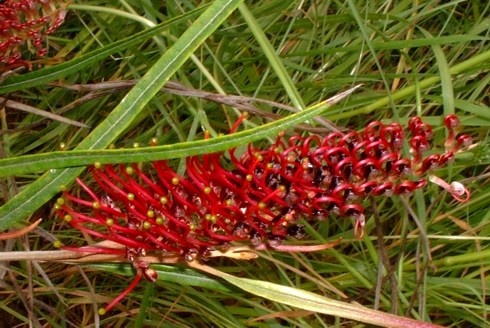
Flowers of Grevillea aspleniifolia in my garden.
|
First, Grevilleas not already introduced to the Northwest, but having the potential to grow here, should be introduced. One could place such plants into three distinct categories. There are hybrid cultivars that are not in cultivation here. For example, the true 'Poorinda Constance' with its bright red flowers probably ought to grow here as it is a cross between two very hardy species (juniperina x victoriae). It might not even be in North America at all. 'Waverley Ghost', a fantastic variegated cultivar originating as a sport of 'Poorinda Constance', is probably the same plant the UCSC Arboretum has labeled as "Grevillea victoriae 'East Gippsland'" - it's not in the Northwest either, but at least it's in California, which isn't so far out of reach. Tens and perhaps hundreds of hybrids old and new exist in Australia and many of these would be worth attempting here, but they remain unavailable. Unfortunately for us, Californians mostly seem to be interested in newer cultivars that aren't especially cold hardy, limiting our ability to obtain hardier species via California. However, I'd love to get my greedy paws on older hybrids that are undervalued and thus rare in mild climates, such as 'Austraflora Copper Crest' (aquifolium x acanthifolia), 'Poodinda Anticipation' (longifolia x willissii), 'Poorinda Peter' (acanthifolia x aspleniifolia or longifolia), or 'Poorinda Pink Coral' (juniperina x victoriae). Another obvious category is Grevillea species that have yet to arrive here. Reliable Australian sources rate many exciting species as hardy to 10 - 15°F or lower. These include G. diminuta, which is like a miniature form of G. victoriae from a very cold mountain range; G. ramosissima, with very prickly leaves and bi-colored flowers; G. wilkinsonii, an upright shrub with long, pendant mauve flowers, and the intriguing G. scortechinii, a groundcover with black flowers; to name a few. And finally, many differing forms of species already in Northwest cultivation deserve a chance here. For example, I've yet to see a deep red or pure yellow G. victoriae, or a broad-leaf form of G. juniperina, or an upright G. x gaudichaudii - they're all out there in the wild, but they're not in Northwest gardens yet. G. victoriae alone probably has 20 different combinations of form and flower color in the wild, each with its own ornamental appeal. Does 20 sound like overkill? Half that many would be vastly more exciting than the two (or three depending on how you count them) we currently have.
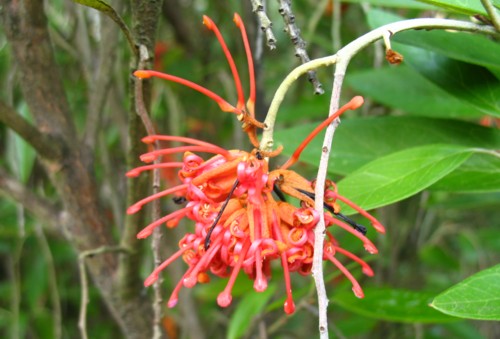
Grevillea victoriae, close up of flowers in my garden in February.
|
Second, new hybrids and cultivars may be developed. The majority of Grevillea cultivars have so far come from Australia, for obvious reasons, plus a few from New Zealand, a handful from California, and one from the Pacific Northwest ('Orange Sparkler'). Even with the hundreds of Grevillea cultivars already registered, old and new, it seems that many species have been left out of the mix of potential parents for interesting hybrids, especially those that have been recently described, or recently introduced to cultivation in Australia. I would list G. barklyana, G. scortechinii, G. laurifolia, G. willissii, G. australis, and G. miqueliana among those species that deserve a look as possible hybrid parents, to start with (some of these have already been used to a limited extent). While not all Grevilleas are closely related enough to cross with each other, the ability to interbreed between Grevillea species that aren't too distantly related is generally good, though germinating the seed may pose an additional obstacle in some cases.
Finally, the practice of grafting Grevilleas may someday be useful to us. It could be a way to grow many Grevillea species and cultivars that are cold hardy enough for us, but aren't happy in our winters because they are fussy about soil drainage or composition, or they dislike the excessive winter precipitation many of us in the Pacific Northwest receive. I suspect some of the toothbrushies may show better performance in Northwest winters if grafted onto the rootstock of some nearly indestructible Grevillea like G. victoriae or G. 'Poorinda Leane'. Species compatibility with each other is generally good, though much more research could be done in this area. This is especially exciting because even a handful of Western Australian Grevilleas, including G. tetragonoloba and G. dieseliana, have been documented to survive down to 12°F in cultivation! Perhaps we may someday see a few of these in our gardens, grafted onto the roots of hardier and more easily grown species.
FURTHER INFORMATION AND READING
I hope you've enjoyed this primer on hardy Grevilleas for the Pacific Northwest. Here are some suggestions for those wishing to investigate Grevilleas more thoroughly.
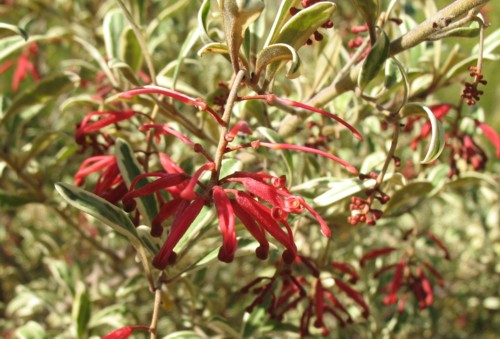
Grevillea 'Waverley Ghost', incorrectly labeled as "Grevillea victoriae
'East Gippsland'" at the UCSC Arboretum, Santa Cruz, California.
|
Peter Olde and Neil Marriott have produced an amazing work called The Grevillea Book, 1995, Timber Press. It is a three volume comprehensive work including botanical descriptions, photos, and extensive commentary on every species of Grevillea. The amount of detail and information in this work is truly astounding. How they managed to write so much and get all those photos, I really can't imagine! Another volume documenting Grevillea cultivars may be forthcoming sometime in the next couple of years.
For something a bit more basic, track down Don Burke's Growing Grevilleas, 1983. It provides a good summary of Grevillea culture with an overview of some of the hardier and more common species and hybrids. While it is an older book, it is still excellent, providing lots of valuable information without being too technical.
A visit to the UCSC Arboretum in California is certain to be educational and fun. They have the largest selection of Grevillea species and hybrids in the US. Unfortunately, some of the hardier species appear not to be at their potential best because the climate there is hotter and drier than what they would like. Leave yourself a whole day to see the place!
Back to Articles |
Home
|



























